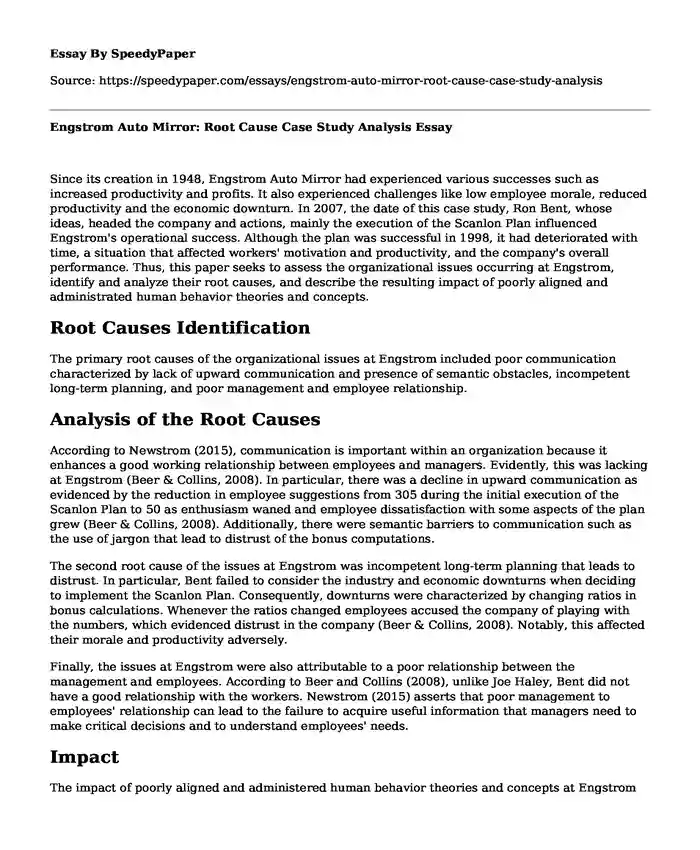
| Type of paper: | Case study |
| Categories: | Organizational behavior Human behavior Business strategy |
| Pages: | 3 |
| Wordcount: | 592 words |
Since its creation in 1948, Engstrom Auto Mirror had experienced various successes such as increased productivity and profits. It also experienced challenges like low employee morale, reduced productivity and the economic downturn. In 2007, the date of this case study, Ron Bent, whose ideas, headed the company and actions, mainly the execution of the Scanlon Plan influenced Engstrom's operational success. Although the plan was successful in 1998, it had deteriorated with time, a situation that affected workers' motivation and productivity, and the company's overall performance. Thus, this paper seeks to assess the organizational issues occurring at Engstrom, identify and analyze their root causes, and describe the resulting impact of poorly aligned and administrated human behavior theories and concepts.
Root Causes Identification
The primary root causes of the organizational issues at Engstrom included poor communication characterized by lack of upward communication and presence of semantic obstacles, incompetent long-term planning, and poor management and employee relationship.
Analysis of the Root Causes
According to Newstrom (2015), communication is important within an organization because it enhances a good working relationship between employees and managers. Evidently, this was lacking at Engstrom (Beer & Collins, 2008). In particular, there was a decline in upward communication as evidenced by the reduction in employee suggestions from 305 during the initial execution of the Scanlon Plan to 50 as enthusiasm waned and employee dissatisfaction with some aspects of the plan grew (Beer & Collins, 2008). Additionally, there were semantic barriers to communication such as the use of jargon that lead to distrust of the bonus computations.
The second root cause of the issues at Engstrom was incompetent long-term planning that leads to distrust. In particular, Bent failed to consider the industry and economic downturns when deciding to implement the Scanlon Plan. Consequently, downturns were characterized by changing ratios in bonus calculations. Whenever the ratios changed employees accused the company of playing with the numbers, which evidenced distrust in the company (Beer & Collins, 2008). Notably, this affected their morale and productivity adversely.
Finally, the issues at Engstrom were also attributable to a poor relationship between the management and employees. According to Beer and Collins (2008), unlike Joe Haley, Bent did not have a good relationship with the workers. Newstrom (2015) asserts that poor management to employees' relationship can lead to the failure to acquire useful information that managers need to make critical decisions and to understand employees' needs.
Impact
The impact of poorly aligned and administered human behavior theories and concepts at Engstrom was dissatisfaction and low employee morale, reduced productivity regarding production efficiency and product quality, and increased losses. In particular, some aspects of the Scanlon plan demoralized employees especially when the company failed to pay bonuses for seven months. Consequently, suggestion rates to express satisfaction dropped and were replaced by consistent complaints regarding distrust of bonus calculations and unfairness (Beer & Collins, 2008). Consequently, productivity levels deteriorated characterized by lack of efficiency and low product quality. This was evidenced by a nearly late delivery of an order to the Toyota plant (Beer & Collins, 2008). Additionally, delayed production caused by the adoption of a new technology led to customer dissatisfaction, which affected the company's sales leading to increased losses. Consequently, Bent was faced by the dilemma of whether to remove the Scanlon plan, change it, or search for other solutions to sustaining productivity and ensuring quality until the downturn ceased (Beer & Collins, 2008).
References
Beer, M., & Collins, E. (2008). "Engstrom Auto Mirror Plant: Motivating in Good Times and Bad." Harvard Business School Brief Case 082-175, April.
Newstrom, J. (2015). Organizational behavior: Human behavior at work (14th ed.). New York, NY: McGraw-Hill.
Cite this page
Engstrom Auto Mirror: Root Cause Case Study Analysis. (2022, Sep 16). Retrieved from https://speedypaper.com/essays/engstrom-auto-mirror-root-cause-case-study-analysis
Request Removal
If you are the original author of this essay and no longer wish to have it published on the SpeedyPaper website, please click below to request its removal:
- Free Essay on Mastering Astronomy
- Free Essay: What Is Mentoring? How Is It Used in Business Today?
- Essay Example on Cyber Security and Risk Response
- Console vs. PC Gaming - Free Essay on Video Games
- Essay Sample on the Connection between Love and Therapy Culture
- Free Paper Sample for Students: Taxation Law and Practice
- Paper Example on Happiness: A Destination or an Ongoing Pursuit
Popular categories




